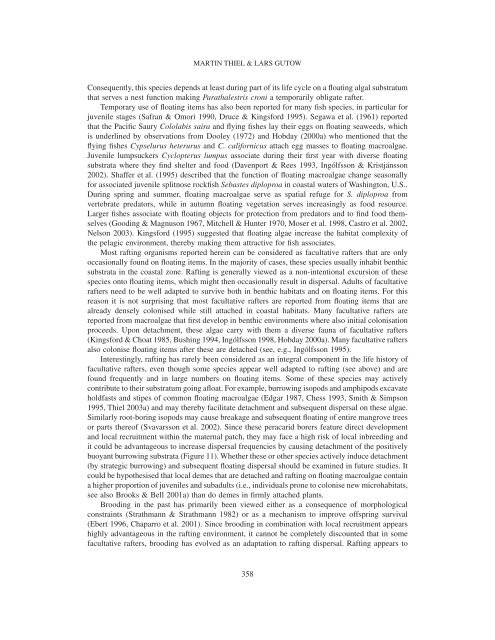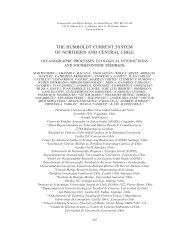The ecology of rafting in the marine environment - Bedim
The ecology of rafting in the marine environment - Bedim
The ecology of rafting in the marine environment - Bedim
Create successful ePaper yourself
Turn your PDF publications into a flip-book with our unique Google optimized e-Paper software.
MARTIN THIEL & LARS GUTOW<br />
Consequently, this species depends at least dur<strong>in</strong>g part <strong>of</strong> its life cycle on a float<strong>in</strong>g algal substratum<br />
that serves a nest function mak<strong>in</strong>g Parathalestris croni a temporarily obligate rafter.<br />
Temporary use <strong>of</strong> float<strong>in</strong>g items has also been reported for many fish species, <strong>in</strong> particular for<br />
juvenile stages (Safran & Omori 1990, Druce & K<strong>in</strong>gsford 1995). Segawa et al. (1961) reported<br />
that <strong>the</strong> Pacific Saury Cololabis saira and fly<strong>in</strong>g fishes lay <strong>the</strong>ir eggs on float<strong>in</strong>g seaweeds, which<br />
is underl<strong>in</strong>ed by observations from Dooley (1972) and Hobday (2000a) who mentioned that <strong>the</strong><br />
fly<strong>in</strong>g fishes Cypselurus heterurus and C. californicus attach egg masses to float<strong>in</strong>g macroalgae.<br />
Juvenile lumpsuckers Cyclopterus lumpus associate dur<strong>in</strong>g <strong>the</strong>ir first year with diverse float<strong>in</strong>g<br />
substrata where <strong>the</strong>y f<strong>in</strong>d shelter and food (Davenport & Rees 1993, Ingólfsson & Kristjánsson<br />
2002). Shaffer et al. (1995) described that <strong>the</strong> function <strong>of</strong> float<strong>in</strong>g macroalgae change seasonally<br />
for associated juvenile splitnose rockfish Sebastes diploproa <strong>in</strong> coastal waters <strong>of</strong> Wash<strong>in</strong>gton, U.S..<br />
Dur<strong>in</strong>g spr<strong>in</strong>g and summer, float<strong>in</strong>g macroalgae serve as spatial refuge for S. diploproa from<br />
vertebrate predators, while <strong>in</strong> autumn float<strong>in</strong>g vegetation serves <strong>in</strong>creas<strong>in</strong>gly as food resource.<br />
Larger fishes associate with float<strong>in</strong>g objects for protection from predators and to f<strong>in</strong>d food <strong>the</strong>mselves<br />
(Good<strong>in</strong>g & Magnuson 1967, Mitchell & Hunter 1970, Moser et al. 1998, Castro et al. 2002,<br />
Nelson 2003). K<strong>in</strong>gsford (1995) suggested that float<strong>in</strong>g algae <strong>in</strong>crease <strong>the</strong> habitat complexity <strong>of</strong><br />
<strong>the</strong> pelagic <strong>environment</strong>, <strong>the</strong>reby mak<strong>in</strong>g <strong>the</strong>m attractive for fish associates.<br />
Most <strong>raft<strong>in</strong>g</strong> organisms reported here<strong>in</strong> can be considered as facultative rafters that are only<br />
occasionally found on float<strong>in</strong>g items. In <strong>the</strong> majority <strong>of</strong> cases, <strong>the</strong>se species usually <strong>in</strong>habit benthic<br />
substrata <strong>in</strong> <strong>the</strong> coastal zone. Raft<strong>in</strong>g is generally viewed as a non-<strong>in</strong>tentional excursion <strong>of</strong> <strong>the</strong>se<br />
species onto float<strong>in</strong>g items, which might <strong>the</strong>n occasionally result <strong>in</strong> dispersal. Adults <strong>of</strong> facultative<br />
rafters need to be well adapted to survive both <strong>in</strong> benthic habitats and on float<strong>in</strong>g items. For this<br />
reason it is not surpris<strong>in</strong>g that most facultative rafters are reported from float<strong>in</strong>g items that are<br />
already densely colonised while still attached <strong>in</strong> coastal habitats. Many facultative rafters are<br />
reported from macroalgae that first develop <strong>in</strong> benthic <strong>environment</strong>s where also <strong>in</strong>itial colonisation<br />
proceeds. Upon detachment, <strong>the</strong>se algae carry with <strong>the</strong>m a diverse fauna <strong>of</strong> facultative rafters<br />
(K<strong>in</strong>gsford & Choat 1985, Bush<strong>in</strong>g 1994, Ingólfsson 1998, Hobday 2000a). Many facultative rafters<br />
also colonise float<strong>in</strong>g items after <strong>the</strong>se are detached (see, e.g., Ingólfsson 1995).<br />
Interest<strong>in</strong>gly, <strong>raft<strong>in</strong>g</strong> has rarely been considered as an <strong>in</strong>tegral component <strong>in</strong> <strong>the</strong> life history <strong>of</strong><br />
facultative rafters, even though some species appear well adapted to <strong>raft<strong>in</strong>g</strong> (see above) and are<br />
found frequently and <strong>in</strong> large numbers on float<strong>in</strong>g items. Some <strong>of</strong> <strong>the</strong>se species may actively<br />
contribute to <strong>the</strong>ir substratum go<strong>in</strong>g afloat. For example, burrow<strong>in</strong>g isopods and amphipods excavate<br />
holdfasts and stipes <strong>of</strong> common float<strong>in</strong>g macroalgae (Edgar 1987, Chess 1993, Smith & Simpson<br />
1995, Thiel 2003a) and may <strong>the</strong>reby facilitate detachment and subsequent dispersal on <strong>the</strong>se algae.<br />
Similarly root-bor<strong>in</strong>g isopods may cause breakage and subsequent float<strong>in</strong>g <strong>of</strong> entire mangrove trees<br />
or parts <strong>the</strong>re<strong>of</strong> (Svavarsson et al. 2002). S<strong>in</strong>ce <strong>the</strong>se peracarid borers feature direct development<br />
and local recruitment with<strong>in</strong> <strong>the</strong> maternal patch, <strong>the</strong>y may face a high risk <strong>of</strong> local <strong>in</strong>breed<strong>in</strong>g and<br />
it could be advantageous to <strong>in</strong>crease dispersal frequencies by caus<strong>in</strong>g detachment <strong>of</strong> <strong>the</strong> positively<br />
buoyant burrow<strong>in</strong>g substrata (Figure 11). Whe<strong>the</strong>r <strong>the</strong>se or o<strong>the</strong>r species actively <strong>in</strong>duce detachment<br />
(by strategic burrow<strong>in</strong>g) and subsequent float<strong>in</strong>g dispersal should be exam<strong>in</strong>ed <strong>in</strong> future studies. It<br />
could be hypo<strong>the</strong>sised that local demes that are detached and <strong>raft<strong>in</strong>g</strong> on float<strong>in</strong>g macroalgae conta<strong>in</strong><br />
a higher proportion <strong>of</strong> juveniles and subadults (i.e., <strong>in</strong>dividuals prone to colonise new microhabitats,<br />
see also Brooks & Bell 2001a) than do demes <strong>in</strong> firmly attached plants.<br />
Brood<strong>in</strong>g <strong>in</strong> <strong>the</strong> past has primarily been viewed ei<strong>the</strong>r as a consequence <strong>of</strong> morphological<br />
constra<strong>in</strong>ts (Strathmann & Strathmann 1982) or as a mechanism to improve <strong>of</strong>fspr<strong>in</strong>g survival<br />
(Ebert 1996, Chaparro et al. 2001). S<strong>in</strong>ce brood<strong>in</strong>g <strong>in</strong> comb<strong>in</strong>ation with local recruitment appears<br />
highly advantageous <strong>in</strong> <strong>the</strong> <strong>raft<strong>in</strong>g</strong> <strong>environment</strong>, it cannot be completely discounted that <strong>in</strong> some<br />
facultative rafters, brood<strong>in</strong>g has evolved as an adaptation to <strong>raft<strong>in</strong>g</strong> dispersal. Raft<strong>in</strong>g appears to<br />
358










